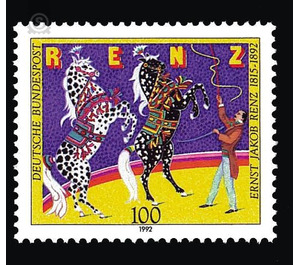100th anniversary of death of Ernst Jakob Renz - Germany / Federal Republic of Germany 1992 - 100 Pfennig
Theme: Animals
| Country | Germany / Federal Republic of Germany |
| Issue Date | 1992 |
| Face Value | 100.00 |
| Color | multi-colored yellow blue |
| Perforation | K 14:13 3/4 |
| Printing Type | Multicolor offset printing |
| Stamp Type | Postage stamp |
| Item Type | Stamp |
| Chronological Issue Number | 1473 |
| Chronological Chapter | GER-BRD |
| SID | 528406 |
| In 53 Wishlists | |
Ernst Jakob Renz was born on 18 May 1815 as one of nine children of a traveling Acrobat family in Böckingen, which today belongs to Heilbronn. For half a century, old Renz and Circus Renz, which he founded, shaped the development of European circus history. In his splendid circus buildings he developed a socially recognized cultural offer for all layers of the population. On April 3, 1892 he died as a highly honored ringmaster in Berlin. Ernst Jakob Renz received his versatile basic artistic education during his apprenticeship with the tightrope walker Maxwell, with the art riding company de Bach and with the circus company Briloff. During these years he also acquired his gifted skills in dealing with horses. In 1842 he founded his own modest company with his wife Antonetta. After some success in larger cities he ventured in 1846 his first appearance in the growing Prussian metropolis Berlin. Already in 1849, Ernst Jakob Renz opened his own permanent wooden circus building in Berlin's Charlottenstraße 90. In the time of German petty-bourgeoisie, old Renz, despite all adverse tariff barriers, had created a modern, all-German large corporation, which flourished after the founding of the Reich the crises of the Wilhelminian era survived brilliantly. For his great merits Ernst Jakob Renz was appointed by the Kaiser to the Prussian Commission Council. After his death he left his son Franz Renz a gigantic enterprise, which possessed reserves in the amount of 16 million Goldmark. He did not have the happy hand of his father in business matters. On July 31, 1897, the old Circus Renz was set up with a farewell performance in the Hamburg circus building. How can the successes of Ernst Jakob Renz be explained? Although he did not know anything about reading and writing, Renz was very open to the rapid technical development of his time. So he organized in 1853 the first special train of a circus in the then still generally rejected railway. Hundreds of unfamiliar gas whisperers lit his buildings, eg. In part, even the then considered revolutionary electric lighting was introduced. In 1855, he was the first to use advertising opportunities on the advertising pillar on a large scale and thus helped her to make a breakthrough. Renz had the ability to absorb the changing public structure in the context of rapid industrialization through the development and differentiation of his circus programs. The classic circus program in its well-known threefoldness of animal performances, clowning and artistry was created under the strict hand of Ernst Jakob Renz. Although Equestrik always remained the mainstay of Renz's life (more than 200 high-quality horses were in his stall), a great variety was developed in the program through the involvement of artists and sensations from Paris, London and overseas: in 1853 Renz showed mounted ostriches, 1854 In 1860, Renz was the first to see beasts of prey in the ring, giraffes and other exotic animals were to follow. Renz also set milestones in the field of artistry: in 1860, the first trapeze flyer flew into the Circus Renz, stretching cartoons made their debut in 1869. Power athletes, bicyclists, tightrope walkers and other artists of all nationalities performed for the first time at Circus Renz. Also attractions from the hype of the fair, such. Siamese twins and dwarfs were shown at Renz. A special focus of Renz was the clowning. Various jokers from all over the world were invited by Renz for z. High fees ("My Klohns do me no harm!"). In 1873 the figure of "Dummen August" was made by Renz in Berlin. The presentation of the program in the form of pantomime was expanded by Renz into artistic showpieces. Pantomimes such as "The Queen of Abyssinia" or "Julius Caesar" were staged with great effort on people, animals and equipment of guest directors who came from the theater. Ernst Jakob Renz recalls Gustav Peter's xylophone piece »Souvenir de Cirque Renz«, which is still known today under the popular name »Renz-Gallop«. (Text: Wolfgang Niedrich, Circus Renz (Directorate Alois and Juliane Renz))


